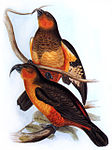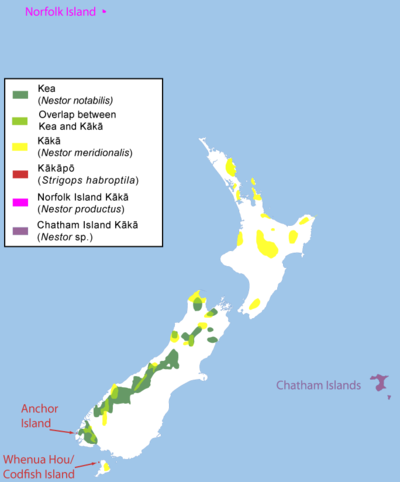New Zealand parrot
| New Zealand parrots Temporal range: Early Miocene to present
| |
|---|---|

| |
| Kākā, North Island subspecies (Nestor meridionalis septentrionalis) at Auckland Zoo, New Zealand | |
| Scientific classification | |
| Domain: | Eukaryota |
| Kingdom: | Animalia |
| Phylum: | Chordata |
| Class: | Aves |
| Order: | Psittaciformes |
| Superfamily: | Strigopoidea Bonaparte, 1849 |
| Family: | Strigopidae Bonaparte, 1849 |
| Genera | |
| Synonyms | |
| |
The New Zealand parrot family, Strigopidae,
The
The family diverged from the other parrots around 82 million years ago when New Zealand broke off from Gondwana, while the ancestors of the genera Nestor and Strigops diverged from each other between 60 and 80 million years ago.[16][17]
Systematics
No consensus existed regarding the taxonomy of
Phylogeography
An unproven hypothesis for the
Until modern times, New Zealand and the surrounding islands were not inhabited by four-legged mammals, an environment that enabled some birds to make nests on the ground and others to be flightless without fear of predation.
The parakeet species belonging to the genus Cyanoramphus (kākāriki) belong to the true parrot family Psittacidae and are closely related to the endemic genus Eunymphicus from New Caledonia. They may have reached New Zealand between 450,000 and 625,000 years ago from mainland Australia by way of New Caledonia, but this is disputed.[23]
Species
Very little is known about the
| Common name (binomial name) Status |
Image | Description | Range and habitat |
|---|---|---|---|
| Nestor | |||
| Kea (Nestor notabilis) Endangered[12]
|
 |
48 cm (19 in) long. Mostly olive-green with scarlet underwings and rump. Dark-edged feathers. Dark brown beak, iris, legs, and feet. Male has longer bill.[26] | New Zealand: AMSL.[27]
|
| South Island kākā (Nestor meridionalis meridionalis) |
 |
Similar to the North Island kākā, but slightly smaller, brighter colours, the crown is almost white, and the bill is longer and more arched in males.[28] | New Zealand: AMSL in summer and 0–550 m in winter.[27]
|
| North Island kākā (Nestor meridionalis septentrionalis) |
 |
About 45 cm (18 in) long. Mainly olive-brown with dark feather edges. Crimson underwings, rump, and collar. The cheeks are golden/brown. The crown is greyish.[28] | New Zealand: AMSL in summer and 0–550 m in winter.[27]
|
| Norfolk kākā |
 |
About 38 cm long. Mostly olive-brown upperparts, (reddish-)orange cheeks and throat, straw-coloured breast, thighs, rump and lower abdomen dark orange.[5] | Formerly endemic on Norfolk Island and adjacent Phillip Island[29] Rocks and trees[5] |
| Chatham kākā (Nestor chathamensis) |
 |
Only known from subfossil bones.[8]
|
Formerly endemic on Chatham Island of New Zealand Forests[8] |
| Strigops | |||
| Kākāpō (Strigops habroptila) Critically endangered[10]
|
 |
Large rotund parrots 58–64 cm (23–25 in) long; males are larger than females and weigh 2–4 kg (4.4–8.8 lb) at maturity. Mostly green with brown and yellow mottled barring, the underparts are greenish-yellow. Its face is pale and owl-like.[30] | New Zealand: AMSL.[27]
|
Common names

All common names for species in this family are the same as the traditional
Ecology

The isolated location of New Zealand has made it difficult for mammals to reach the island. This is reflected in the absence of
The three extant species of this family occupy rather different ecological niches, a result of the phylogeographical dynamics of this family. The kākāpō is a
The kea is well adapted to life at high altitudes, and they are regularly observed in the snow at ski resorts. As trees are absent in the alpine zone, they breed in hollows in the ground instead of in tree hollows like most parrot species.
Relationship with humans
Importance to the Māori
The parrots were important to the Māori in various ways. They hunted them for food, kept them as pets, and used their feathers in weaving
Status
Of the five species, the Norfolk kākā.
Threats
The fauna of New Zealand evolved in the total absence of humans and other mammals. Only a few bat species and sea mammals were present prior to colonisation by humans, and the only predators were birds of prey that hunt by sight. These circumstances influence the design of New Zealand's parrots, for example, the flightlessness of the kākāpō and the ground breeding of the kea.[39] Polynesians arrived at Aotearoa between 800 and 1300 AD,[46] and introduced the kurī (dog) and kiore (Polynesian rat) to the islands.[39][47] This was disastrous for the native fauna, because mammalian predators can locate prey by scent, and the native fauna had no defence against them.[39]
The kākāpō was hunted for its meat, skin, and plumage. When the first European settlers arrived, the kākāpō was already declining, but still widespread.[39] The large-scale clearance of forests and bush destroyed its habitat while introduced predators such as rats, cats, and stoats found the flightless, ground-nesting birds easy prey.
The New Zealand kākā needs large tracts of forest to thrive, and the continued fragmentation of forests due to agriculture and logging has a devastating effect on this species. Another threat comes from competition with introduced species for food, for example with possums for the endemic mistletoe and rata and with wasps for shimmering honeydew, an excretion of scale insects. Females, young, and eggs are particularly vulnerable in the tree hollows in which they nest.
The kea nests in holes in the ground, again making it vulnerable to introduced predators. Another major threat, resulting from development of the alpine zone, is their opportunistic reliance on human food sources as their natural food sources dwindle.[15]
Conservation
Recovery programs for the kākāpō and the kākā have been established, while the kea is also closely monitored.[48] The 247 as of 2023.[49] living kākāpō are all in a breeding and conservation program. Each one has been individually named.
See also
- Kākāriki, New Zealand parakeets
- Fauna of New Zealand
References
- ^ Nestoridae and Strigopidae are described in the same article, Bonaparte, C.L. (1849) Conspectus Systematis Ornithologiae. Therefore, under rules of the ICZN, the first reviser determines priority, which is Bonaparte, C.L. (1850), Conspectus Generum Avium, E.J. Brill, Leyden.
- ISBN 978-0-643-06511-6.
- S2CID 86361015.
- PMID 31387471.
- ^ ISBN 0-7153-7698-5.
- ^ Millener, P. R. (1999). "The history of the Chatham Islands' bird fauna of the last 7000 years – a chronicle of change and extinction. Proceedings of the 4th International meeting of the Society of Avian Paleontology and Evolution (Washington, D.C., June 1996)". Smithsonian Contributions to Paleobiology. 89: 85–109.
- ISBN 978-1501704697. Retrieved 17 September 2022.
- ^ a b c d e f Millener, P. R. (1999). "The history of the Chatham Islands' bird fauna of the last 7000 years – a chronicle of change and extinction. Proceedings of the 4th International meeting of the Society of Avian Paleontology and Evolution (Washington, D.C., June 1996)". Smithsonian Contributions to Paleobiology. 89: 85–109.
- ^ . Retrieved 12 November 2021.
- ^ . Retrieved 12 November 2021. Database entry includes a range map and justification for why this species is endangered,
- ^ . Retrieved 12 November 2021. Database entry includes a range map and justification for why this species is endangered.
- ^ . Retrieved 12 November 2021. Database entry includes a range map and justification for why this species is endangered.
- ^ "Threats to Kākāpō". Department of Conservation Te Papa Atawbai. Archived from the original on 2009-04-04. Retrieved 2008-12-31.
- ^ "Threats to Kākā". Department of Conservation Te Papa Atawbai. Archived from the original on 2008-12-31. Retrieved 2008-12-31.
- ^ a b "Threats to Kea". Department of Conservation Te Papa Atawbai. Archived from the original on 2009-10-03. Retrieved 2008-12-31.
- ^ PMID 18653733.
- ^ a b c d e f Grant-Mackie, E.J.; J.A. Grant-Mackie; W.M. Boon; G.K. Chambers (2003). "Evolution of New Zealand Parrots". NZ Science Teacher. 103.
- ^ For a discussion about older taxonomic positions, see Sibley, Charles Gald; Jon E. Ahlquist (1991). Phylogeny and Classification of Birds. Yale University Press. For more recent taxonomies, see Christides.
- ^ a b c Leo Joseph, Alicia Toon, Erin E. Schirtzinger, Timothy F. Wright & Richard Schodde. (2012) A revised nomenclature and classification for family-group taxa of parrots (Psittaciformes). Zootaxa 3205: 26–40
- ISBN 978-0-8138-2749-0.
- S2CID 46659963. Archived from the originalon 2012-10-05.
- PMID 16099384.
- ^ Boon, W. M.; Kearvell, J.; Daugherty, C. H.; Chambers, G. K. (2001). "Molecular systematics and conservation of kakariki (Cyanoramphus spp.)" (PDF). Science for Conservation. 176.
- S2CID 86361015.
- PMID 31387471.
- ^ "Kea – BirdLife Species Factsheet". BirdLife International. 2008.
- ^ ISBN 978-0300074536.
- ^ a b c "Kaka – BirdLife Species Factsheet". BirdLife International. 2008.
- ^ a b "Norfolk Island Kaka – BirdLife Species Factsheet". BirdLife International. 2008.
- ^ a b "Kakapo – BirdLife Species Factsheet". BirdLife International. 2008.
- ^ "Maori Bird Names". Kiwi Conservation Club. Archived from the original on 22 May 2010. Retrieved 12 December 2012.
- ^ "Kaakaa". Polynesian Lexicon Online. Retrieved 2012-02-29.
- ^ "kakapo". The American Heritage Dictionary of the English Language: Fourth Edition. 2000. Archived from the original on 2008-04-20. Retrieved 2008-12-31.
- ^ "The Māori Language – Ko Te Reo". Retrieved 2009-01-01.
- ^ "Māori dictionary". Retrieved 2009-01-02.
- ^ "kea". The American Heritage Dictionary of the English Language: Fourth Edition. 2000. Archived from the original on 2008-04-18. Retrieved 2008-12-31.
- ISBN 978-1-86969-161-5.
- ^ "Kahu huruhuru (feather cloak)". Museum of New Zealand Te Papa Tongarewa. Retrieved 2008-12-31.
- ^ a b c d e f Tipa, Rob (2006). "Kakapo in Maori lore" (PDF). Notornis. 53: 193–194. Archived from the original (PDF) on 2008-10-14.
- ^ "Putting Together a Mihi for a Hui" (PDF). maori.org.nz Main Maori Site on the Net!. Retrieved 2009-01-02.
- ^ "Slideshow: Manu – Birds". maori.org.nz Main Maori Site on the Net!. Archived from the original on 2009-02-16. Retrieved 2009-01-02.
- ^ Greenway, James Cowan (1967). Extinct and Vanishing Birds of the World (2nd ed.). New York: Dover Publications.
- ^ "Nestor productus – Norfolk Island Kaka specimen(s) in the ZMA". Nlbif.eti.uva.nl. Archived from the original on 2011-06-08. Retrieved 2008-12-28.
- ^ "Naturalis – Extinct bird: Nestor productus (Norfolk Island Kaka)". Nlbif.eti.uva.nl. Archived from the original on 2011-06-08. Retrieved 2008-12-28.
- ^ "Kākāpō Recovery". Department of Conservation. New Zealand. Retrieved 28 August 2023
- ISBN 1-86940-098-4.
- ^ Tahana, Yvonne (2 June 2010). "Rare rats off the hook as DoC gives them island sanctuary". The New Zealand Herald. Retrieved 17 February 2019.
- ^ "DOC's work with Kea". Department of Conservation Te Papa Atawbai. Archived from the original on 2009-10-04. Retrieved 2008-12-31.
- ^ "Kākāpō Recovery". Department of Conservation. New Zealand. Retrieved 28 August 2023

